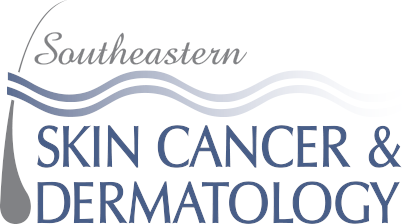Wrinkles
Home » Dermatology » Wrinkles
Wrinkles are a by-product of the aging process.
With age, skin cells divide more slowly, and the inner layer (called the dermis) begins to thin. The network of elastin (the protein which causes skin to stretch) and collagen fibers (the major structural proteins in the skin), loosen and unravel, causing depressions on the surface. With aging, skin also loses its elasticity, is less able to retain moisture, oil-secreting glands are less efficient and the skin is slower to heal. All of these contribute to the development of wrinkles.
Facial Muscle Contractions
Lines between the eyebrows (frown lines) and lines around the corner of the eyes (crows feet) develop because of small muscle contractions. Smiling, frowning, squinting and other habitual facial expressions cause these wrinkles to become more prominent. Over time, the expressions coupled with gravity contribute to the formation of jowls and drooping eyelids.
Sun Damage and Wrinkles
Exposure to ultraviolet radiation (sun and tanning beds) can result in premature aging of skin through damage to the collagen and elastin. Premature aging of the skin is called photoaging. When ultraviolet light damages skin tissue, an enzyme called metalloproteinase is produced. This enzyme creates and reforms collagen. During the process, however, some healthy collagen fibers are damaged, resulting in a disorganized formation of fibers. Wrinkles develop through this repeated rebuilding process.
Smoking and Wrinkles
Healthy, normal skin perpetually regenerates. While old collagen is broken down and removed, new collagen is produced. Researchers have found that smoking and tobacco use cause a marked reduction in the production of new collagen. A lack of new collagen results in the development of wrinkles.
What Are the Treatment Options for Wrinkles?
Please also see our Cosmetic section
There are numerous over-the-counter treatment options for wrinkles, including various creams and lotions. Prescription treatments, including the retinoid creams (such as Retin-A), are also an option. Removing skin layers to reduce wrinkles or irregular depressions is an effective way to regain smoother, more youthful-looking skin.
Dermabrasion (scraping layers away) and chemical peels (dissolving skin away) are two of the traditional methods used in skin resurfacing. Laser resurfacing with an ablative laser is another technique that, like dermabrasion and deeper chemical peels, may require some downtime during the healing process.
Other lasers, known as non-ablative lasers, may also be beneficial in treating wrinkles. These lasers work by heating the dermis and stimulating collagen growth. This process, which leaves the outer layers of skin intact, has minimal to no downtime associated with it. However, the results are not as dramatic as the ablative lasers which actually remove the surface layers of skin.
Botox, collagen, and other injections are the additional techniques available to help minimize wrinkles. We offer Botox treatments specifically based on your facial movement and anatomy rather than just “cookie-cutter” injections – there is a difference. Also, we use injectable fillers such as Juvederm, Voluma, and Volbella to restore natural volume and changes that occur with age. If you are considering treatment for your wrinkles, ask your doctor which procedure is right for you. There is no replacement for your doctor’s professional advice. Each person has his or her own individual needs; similarly, each procedure fulfills its own specific purpose.





